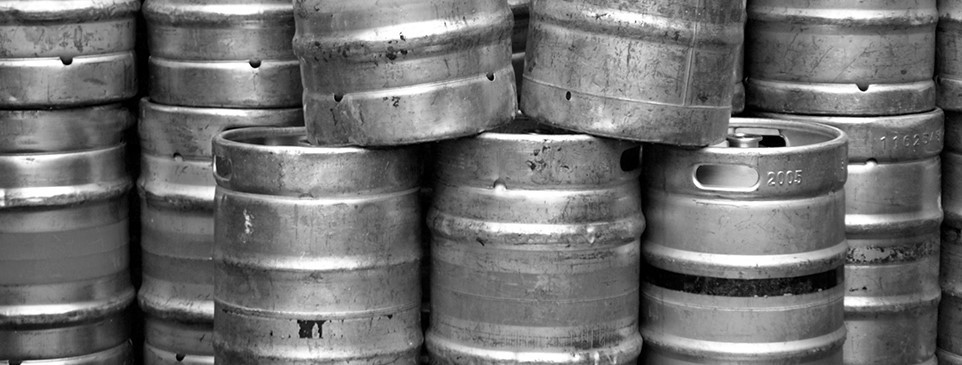Roll Out The Barrel

As a landlord you spend many hours rolling those metal beer containers around your cellar but have you ever stopped to think about why they are that shape and size.
The first point to make is that a barrel is a measure, 36 gallons of beer, not a type of container and a cask is just a name for a container the beer comes in. The following names are specific to the volume of beer in the container.
The standard size for cask beer is a firkin, meaning forth of a barrel (middle dutch) and contains 9 gallons. The next size is a kilderkin, meaning half a barrel (middle dutch) and contains 18 gallons. Next up is a barrel which is 36 gallons and then you have a hogshead, (originally called an oxhead due to the fact that they were branded with the sign of an ox head) and these contain 54 gallons. Two sizes that you never see in pubs are a butt which is two hogsheads, 108 gallons and a tun which is two butts or 216 gallons. In fact some brewers have gone the other way into smaller containers and send their beer out in a pin which is half a firkin or 4.5 gallons. These can also be made of plastic and if they are they are called polypins.
It is useful to remember these sizes, it’s very common for landlords to talk about selling 10 barrels a week when they actually mean 10 firkins. The difference between 2880 pints and 720 pints is a lot!
So why is a barrel the shape it is? Well it’s mainly down to strength, as a cylindrical container is stronger than a square one. They have a convex shape and the bulge in the middle is called the bilge or belly of the barrel. This shape makes them easier to roll in a straight line and also easier to stack on top of each other. It also has the added effect that when they are stillaged flat on their sides the yeast in a cask conditioned beer has a larger surface area to settle into and this area is below the level of the cask tap so minimises the likelihood of sediment being drawn into the beer lines. Around the top and bottom of the barrel is the chime ring. These normally have slots in them to allow the drainage of water although most people tend to use them as handles, which they were not designed for hence the reason they can have sharp edges. The last two parts of the barrel are the keystone, situated at the end of the barrel towards the bottom where the cask tap is inserted, and the shive, where the beer is vented from found on the curved side of the barrel. This is arranged so that when the barrel is on its side the keystone is at the lowest part of the rim and the shive will be at the highest.
There are three main methods of dispensing beer, flat stillage via a cask tap, upright stillage via a metal spear or a plastic floating widget.
Traditionally flat stillage is the preferred method as already mentioned, the design of the barrel facilitates the best removal of the yeast sediment. However, in cellars where space is a premium upright stillage may be adopted as an alternative method. The metal spear is designed to be inserted into the barrel via the keystone and lowered to the bottom then slightly raised to lie above the sediment level, however it is not always easy to determine this and coupled with the fact that you cannot sample the beer prior to connecting to the beer lines means you can run the risk of getting cloudy beer into the lines. The second method using the floating widget alleviates this problem as the widget is designed to float on the top of the beer with its outlet just under the surface. However, it brings its own issues as you are always taking beer from the top where it is starting to oxidise and you can pull air into your beer lines causing the hand pulls to become “spongy” when operated. As they say sometimes needs must and with careful use the two upright dispense methods can be used successfully in smaller cellars.
In a future article we will look at the design of kegs and how these have evolved to cope with beers that are dispensed under pressure but in the meantime, good luck when you “roll out the barrel, cask, kil, pin …”
